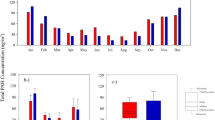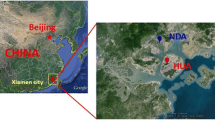Abstract
Persistent organic pollutants (POPs), including polycyclic aromatic hydrocarbons (PAHs), organochlorine pesticides (OCPs), phthalic acid esters (PAEs), and polychlorinated biphenyls (PCBs), were systemically investigated in total solid particles (TSPs) sampled at seven sites in Shandong province, China. The congener profile and space distribution were compared during district heating period (DHP) in winter and non-district heating period (N-DHP) in spring. The air pollution at in-land sites was worse than that at seashore sites due to the different ventilation conditions and pollutant sources. The concentrations of PAHs associated to the distribution of TSP, severer in DHP, since coal burning was the major source for both pollutants, according to the analysis of these results and diagnostic ratios. FLT, PYR, and BBF were top PAH congeners by specific mass concentrations. On the profile, OCPs, PCBs, and PAEs were more related to the ambient temperature due to the evaporation and revealed higher abundancy in N-DHP than in DHP. Based on the diagnostic ratio analysis, the source of pollution was more likely local than remote.







Similar content being viewed by others
References
Arruti A, Fernández-Olmo I, Irabien Á (2012) Evaluation of the urban/rural particle-bound PAH and PCB levels in the northern Spain (Cantabria region). Environ Monit Assess 184:6513–6526
Baek SY, Choi SD, Chang YS (2011) Three-year atmospheric monitoring of organochlorine pesticides and polychlorinated biphenyls in polar regions and the South Pacific. Environ Sci Technol 45:4475–4482
Bartos T, Cupr P, Klánová J, Holoubek I (2009) Which compounds contribute most to elevated airborne exposure and corresponding health risks in the Western Balkans? Environ Int 35:1066–1071
Castrojiménez J, Mariani G, Vives I, Skejo H, Umlauf G, Zaldívar JM, Dueri S, Messiaen G, Laugier T (2011) Atmospheric concentrations, occurrence and deposition of persistent organic pollutants (POPs) in a Mediterranean coastal site (Etang de Thau, France). Environ Pollut 159:1948
Chen S, Xu L, Zhang Y, Chen B, Wang X, Zhang X, Zheng M, Chen J, Wang W, Sun Y (2017) Direct observations of organic aerosols in common wintertime hazes in North China: insights into direct emissions from Chinese residential stoves. Atmos Chem Phys 17:1259–1270
Duan Z, Han X, Bai Z, Yuan Y (2016) Fine particulate air pollution and hospitalization for pneumonia: a case-crossover study in Shijiazhuang, China. Air Qual Atmos Health 9:723–733
El-Mubarak AH, Rushdi AI, Al-Mutlaq KF, Bazeyad AY, Simonich SLM, Simoneit BRT (2015) Occurrence of high levels of persistent organic pollutants (POPs) in particulate matter of the ambient air of Riyadh, Saudi Arabia. Arab J Sci Eng 40:81–92
Fang GC, Wu YS, Chen MH, Ho TT, Huang SH, Rau JY (2004) Polycyclic aromatic hydrocarbons study in Taichung, Taiwan, during 2002–2003. Atmos Environ 38:3385–3391
Li J, Gan Z, Guo L, Xu W, Li X, Lee CSL, Ding A, Tao W (2007) Organochlorine pesticides in the atmosphere of Guangzhou and Hong Kong: regional sources and long-range atmospheric transport. Atmos Environ 41:3889–3903
Li Y, Henze DK, Jack D, Kinney PL (2016) The influence of air quality model resolution on health impact assessment for fine particulate matter and its components. Air Qual Atmos Health 9:51–68
Liu Z, Li N, Wang N (2016) Characterization and source identification of ambient VOCs in Jinan, China. Air Qual Atmos Health 9:285–291
Ma Q, Cai S, Wang S, Zhao B, Martin RV, Brauer M, Cohen A, Jiang J, Zhou W, Hao J (2017) Impacts of coal burning on ambient PM 2.5 pollution in China. Atmos Chem Phys 17:4477–4491
Nie H, Fu S, Dong Y, Yang Z (2014) Polychlorinated biphenyls in respirable particulate matter from different industrial areas in northern China. Chemosphere 114:210
Odabasi M, Cetin B, Bayram A (2015) Persistent organic pollutants (POPs) on fine and coarse atmospheric particles measured at two (urban and industrial) sites. Aerosol Air Qual Res 15:1894–1905
Offenberg J, Baker J (1999) Aerosol size distributions of polycyclic aromatic hydrocarbons in urban and over-water atmospheres. Environ Sci Technol 33:356–360
Pan J, Yang YL, Zhang G, Shi JL, Zhu XH, Li Y, Yu HQ (2011) Simultaneous observation of seasonal variations of beryllium-7 and typical POPs in near-surface atmospheric aerosols in Guangzhou, China. Atmos Environ 45:3371–3380
Sheng J, Wang X, Gong P, Joswiak DR, Tian L, Yao T, Jones KC (2013) Monsoon-driven transport of organochlorine pesticides and polychlorinated biphenyls to the Tibetan plateau: three year atmospheric monitoring study. Environ Sci Technol 47:3199–3208
Simcik MF, Eisenreich SJ, Lioy PJ (1999) Source apportionment and source/sink relationships of PAHs in the coastal atmosphere of Chicago and Lake Michigan. Atmos Environ 33:5071–5079
Wang P, Wang SL, Fan CQ (2008) Atmospheric distribution of particulate- and gas-phase phthalic esters (PAEs) in a Metropolitan City, Nanjing, East China. Chemosphere 72:1567
Wang J, Xing J, Mathur R, Pleim JE, Wang S, Hogrefe C, Gan CM, Wong DC, Hao J (2016) Historical trends in PM2.5-related premature mortality during 1990-2010 across the northern hemisphere. Environ Health Perspect 125:400–408
Zhang L, Zhang T, Dong L, Shi S, Zhou L, Huang Y (2013) Assessment of halogenated POPs and PAHs in three cities in the Yangtze River Delta using high-volume samplers. Sci Total Environ 454-455C:619–626
Zhang Y, Cai J, Wang S, He K, Zheng M (2017) Review of receptor-based source apportionment research of fine particulate matter and its challenges in China. Sci Total Environ 586:917–929
Acknowledgements
The work was responded by National Natural Science Foundation of China (CN) (21407097) and Science and Technology Development Project of Shandong Province (2014GSF117002).
Author information
Authors and Affiliations
Corresponding author
Rights and permissions
About this article
Cite this article
Zhang, G., Wang, N., Cheng, X. et al. Distribution of persistent organic pollutants (POPs) in atmospheric particles during district heating period (DHP) and non-district heating period (N-DHP) in Shandong province, China. Air Qual Atmos Health 10, 1247–1257 (2017). https://doi.org/10.1007/s11869-017-0509-5
Received:
Accepted:
Published:
Issue Date:
DOI: https://doi.org/10.1007/s11869-017-0509-5




